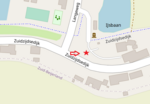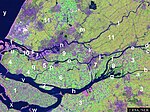The Volkerakdam (English: Volkerak Dam) or Volkerakwerken (Volkerak Works) is the name given to a group of hydraulic engineering structures located between Goeree-Overflakkee and North Brabant in The Netherlands. The works are not a single dam, but are composed of three distinct structures: a dam between Goeree-Overflakkee and Hellegatsplein, a series of locks from Hellegatsplein to North Brabant, and a bridge from Hellegatsplein to Hoekse Waard. The works cross three separate bodies of water: the Haringvliet, Hollands Diep and Volkerak. The works together comprise the fifth project of the Delta Works.
The works were conceived in response to the North Sea flood of 1953, as a result of which it was decided to close the inlets in Zeeland and South Holland. The committee which oversaw the Delta Works concluded that it was necessary to construct two compartmentalisation dams, the Grevelingendam and the Volkerakdam, in order to close the inlets. It was also deemed necessary to separate the Haringvliet from the waters to the south, in order to ensure the transport of drift ice from the Hollands Diep to the sea, and to keep the water quality of the (planned) Zeeland Lake acceptable, preserving it from contaminated Rhine water.
In addition, a fixed water level on the Zeeland Lake was desirable for the purpose of shipping between Antwerp and Rotterdam, as the water level on the Haringvliet would vary due to the varying discharge of the Rhine. The construction of the Volkerakdam modified tidal movements across the entire area of the lower rivers, with extensive calculations made using the Deltar analogue computer to analyse these tidal variations.The Volkerakdam has a supporting environmental function with regard to the primary dams of the Oosterscheldekering, the Brouwersdam and the Haringvlietdam, controlling volumes of freshwater from the Maas and the Waal which enter the waters around Zeeland. As a result of the closure of the Volkerak, the volume of fresh Rhine water entering the estuary decreased. Consequently, the salinity of the Oosterschelde remained relatively constant, increasing the ecological value of the estuary.The Volkerakdam works also removed the difficulties experienced by shipping from the limited (but very unpredictable) tidal currents in the Hellegat, which had previously resulted in many ships being lost.






